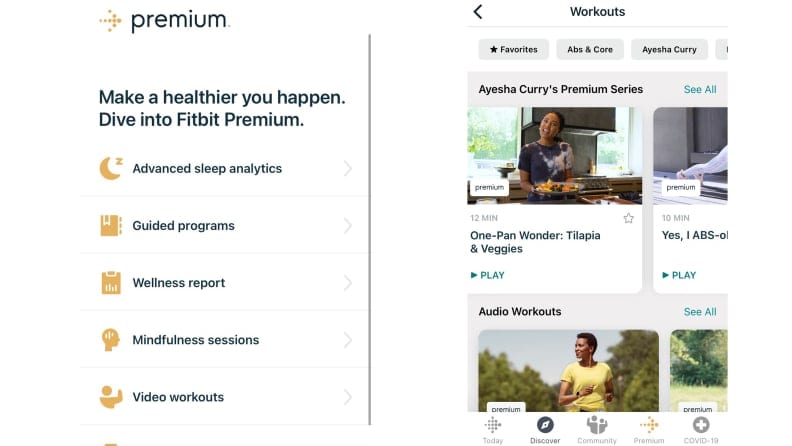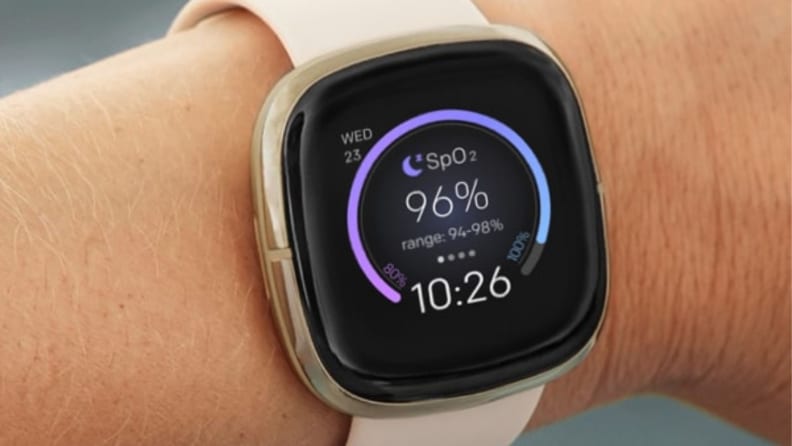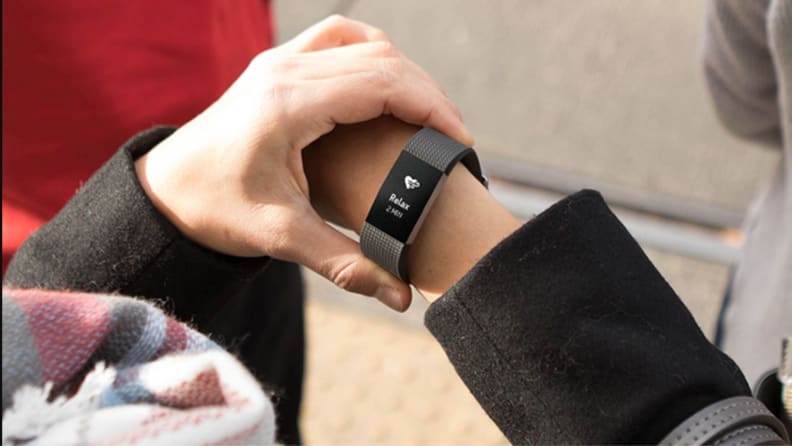Is Fitbit's new meditation content worth the premium price?
Fitbit aims to go beyond fitness with new meditation content—here's how it compares to apps like Headspace.
Products are chosen independently by our editors. Purchases made through our links may earn us a commission.
Mindfulness seems to be everywhere you look, these days. From meditation apps to floor cushions designed for the practice—it’s a stress-reducing habit that doesn't seem to be going anywhere soon. Fitbit, which carries an ever-growing array of fitness wearables, had to get in on the action, too, with a splashy rollout of meditation features available for those who pay for its Fitbit Premium app. Premium also offers workouts and fitness programming, which Reviewed’s health and fitness editor, Sara Hendricks, tested out. But as Reviewed’s resident meditation expert and sleep writer, I had to know: Do the meditation features alone make Fitbit Premium worth the price?
What is Fitbit Premium?

Fitbit Premium gives users access to a variety of features, ranging from workouts to the full library of meditation sessions.
A Fitbit Premium subscription provides access to additional features within its free app for an additional cost. These features include deeper data and analysis on your health stats as captured by the sensors on your compatible Fitbit wearable, as well as access to Fitbit's complete library of content including workouts and—most importantly for me—meditation sessions. An annual Fitbit Premium membership costs $80, though the purchase of a new Fitbit Inspire 2 comes with a year-long free trial, and a new Fitbit Sense comes with a six-month trial. If you already own a Fitbit, and want to get in on the action, you can give the service a go with a 90-day free trial (assuming you haven't already tried Premium in the past).
What meditation features does Fitbit Premium offer?
Fitbit has dabbled in meditation since August of 2019, when it first launched its Premium service. In early 2020, it started an ongoing collaboration with another well-known digital meditation service, Ten Percent Happier. As such, users can find a handful of sessions led by guides who produce content for both apps, like meditation teacher Sebene Selassie.
Recently, Fitbit began expanding its in-house meditation and mindfulness library for Fitbit Premium users with an exclusive series of 28 sessions led by Deepak Chopra, called the “Mindful Method.” Chopra is a well-known meditation expert and doctor who’s regarded for his role in popularizing mindfulness and meditation. He’s also the founder of the Chopra Foundation, a non-profit that aims to make mindfulness and wellness more accessible to “disadvantaged individuals and communities.”
To access meditation content, you start on the Fitbit app home screen, which displays your steps and other basic data. From there, you scroll down and tap on the “Track your mindfulness” subsection. A few meditations are displayed on that page. To explore the whole library, you tap “see all,” which is positioned near the middle of the right-side of your phone. Chopra’s sessions aren’t the only ones available to Fitbit Premium users. The meditations run the spectrum from general mindfulness sessions to options for evoking certain feelings, if you want to destress for a moment or feel more purpose. There’s even a “Coffee Meditation,” which supposedly helps you “get grounded and even joyful during your daily routine by mindfully easing you into the day and appreciating the simple moments in life.” Sessions range in length from 2 minutes to 45 minutes, though most fall in the 10- to 15-minute range. Chances are, you can find a way to fit one into your day.
Can I use Fitbit’s meditation content without any Fitbit device?

The Fitbit Sense has sepcific features, including an EDA scanner, that can give you even more insight into your body's response to meditations.
The short answer is yes. The meditation content is piped through the app so, in theory, you don’t need a Fitbit device at all. But if you want feedback showing the physiological effects that meditation has, you’ll get more or less detail depending which wearable you own. Some of the meditation content is designed with the Fitbit’s newest and most advanced smartwatch, the Sense, in mind. (The sessions are listed under a subsection called “Sessions for your Sense.”) The Fitbit Sense has a feature that monitors electrodermal activity (or EDA) responses, which works by analyzing “small changes to your skin which may indicate your body’s response to stress.” Other Fitbits with a heart rate monitor—including every device that the company currently sells—may allow you to watch your pulse (hopefully) decrease while you meditate. With the Sense, you hold your hand over its face to do an EDA scan during your mediation, and you get a quick overview of your session stats after you finish.
Though Sense has a handful of special sessions that work with the EDA function, it’s not the only Fitbit device with a built-in meditation function. Several Fitbit models offer an on-device, guided-breathing practice called “Relax.” This feature is minimalist but practical in terms of offering you a way to take a (literal) breather. I tried it on the Sense, so that’s what I’ll focus on here, though it’s also available on the Charge 4 our favorite Fitbit), the Inspire line, and Versa series, (as well as a few older now-discontinued models, including the Blaze and Ionic). To use it on the Sense, you open the “Relax app” (which is a little heart icon with lines resembling wind on it), and select a session duration of 2 or 5 minutes. The Sense’s face then displays an animated ring that expands and contracts against which you time your inhales and exhales. The watch also vibrates your wrist slightly with a different pattern to tell you when to breathe in or out, so you can use the feature without even looking at the screen.
How did I test Fitbit’s meditation content?

In testing, I found myself reaching for the "Relax" feature, which is built-in to a handful of Fitbit's trackers.
I tested the Fitbit like anyone would: I tried different meditations through the Fitbit app, in conjunction with the Fitbit Sense. I experimented with sleep-specific meditations at night, and tried others designed for daytime use. I paid attention to my heart rate and changes in my breathing before, during, and after daytime sessions and considered how useful and effective the whole program was.
Where my testing differs is my expertise: As the sleep writer for Reviewed, I’ve evaluated numerous meditation apps, like Headspace and Calm, as well as meditation offerings from other devices, like the Hatch Restore. From sessions targeting destressing to those designed with sleep in mind, I’ve tried 'em all.
What’s good about Fitbit’s meditation content?
Fitbit has a reasonable selection of meditations, which I came to appreciate, but it’s still smaller than some other apps, like Headspace and Calm (which, to be fair, have a several years' head start on accumulating a library). Fitbit's sleep meditations were great—they never failed to knock me out. As such, while I would love to give you more details as to what happened in the sessions, I cannot remember. That said, though effective, I didn’t find them quite as enjoyable or compelling as those offered by app-based meditation competitors, namely Headspace (which we deemed the best meditation app overall).
To be honest, I more frequently reached for the short guided-breathing exercise, "Relax," on the Sense itself, as opposed to the sessions in the app. If I didn’t personally own an early Versa with the same guided-breathing feature (which I didn’t even know about until writing this review), I would consider purchasing the Sense purely for that function.
Fitbit’s new series with Chopra has a decent selection of options, many of which target breathing. For the most part, I liked the Chopra content. I found his sessions quite soothing, and that they effectively quelled any stress I felt during the day (which I could also see in the data collected by the Sense, indicating that my heart rate generally was slower following sessions). The company claims it plans to keep adding to the series over time, so users can expect the library to grow.
What’s not good about Fitbit’s meditation content?
In my opinion, Headspace is tough competition. Fitbit made a valiant effort, but its current features can’t compete.
I found the lack of customizability of individual meditation sessions a disappointment—Headspace allows you to adjust the duration of sessions. Many Headspace sessions can be set for 3, 5, or 10 minutes, and longer ones can be set to last for 10, 15, or 20 minutes. On Fitbit Premium, you can actively seek out a shorter session, say, one that's less than 5 minutes, or a longer one that’s 20 to 30 minutes, but you can’t adjust the duration of specific sessions at all.
One thing I noticed across Fitbit’s meditations was consistently long pauses of silence within the narration. The periods of silence in the meditations felt longer than those of other apps, which was strange. That’s not to say that they were always bad, but on occasion, I wished for more guidance or at least a little chatter so I didn’t drift off into my own thoughts. This was especially true when I was doing deep breathing. Folks who have practiced meditation for years may not need, or want, ongoing instructions, so the lack thereof could be a plus for them. But as someone who still feels relatively new to the practice, I wanted someone to tell me exactly when to inhale and exhale (and to keep going, with gentle reminders). The meditations led by Chopra seemed to have a better cadence and the pauses felt more natural to me. However many of those were underlaid with music, which isn’t my favorite. (Yes, I realize I just said I didn’t like prolonged silence, but I also don’t care for filler music, either. I might as well go by “meditation Goldilocks,” at this point.)
Another small bother is the fact that the narrators for meditations are not always identified in the app's blurb descriptions. I would find someone whose meditation style I liked, only to realize I couldn’t readily track down additional meditations led by that person. (Yet another area where I feel spoiled by Headspace, which always lists the speaker, so you can select sessions based on your favorite narrator or expert.)
The Fitbit Premium app navigation isn’t stellar, either. For a few days, I had a hard time remembering how to even find the meditation library. Once you’ve used it a few times and are accustomed to the navigation, it’s easier, but it’s a lot of screen taps to get there. Moreover, at times the app seemed to glitch when I scrolled through the library, bumping me back up to sessions I’d scrolled past, or making the screen look almost as though it was shaking a bit. Not a huge issue, but still a deterrent.
Is Fitbit’s meditation content worth it?
The new Fitbit Premium meditation content is nifty, but I can’t see myself developing a sustained practice using it. The sessions are good, but not that good. In testing other apps, I came to look forward to meditating with certain ones. Fitbit’s sessions are fine, but not something I eagerly anticipated.
The other Premium features that come with the subscription seem cool, including fitness programs and advanced sleep analytics, and if you have a Fitbit already, buying into the subscription could be worthwhile from a holistic wellness perspective. But if you don’t have a Fitbit and are looking for an app to use solely for meditation purposes, I’d opt for Headspace (or Calm, or any number of other dedicated meditation apps). If you own a newer Fitbit and you’re just looking for a quick break, the built-in Relax feature available on most devices is more worth it—and it doesn’t cost an extra membership fee.
